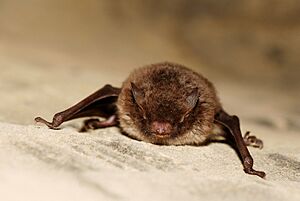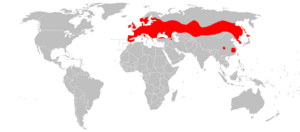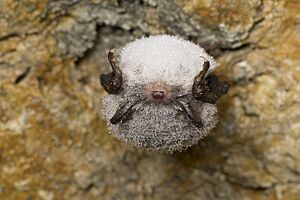Daubenton's bat facts for kids
Quick facts for kids Daubenton's bat |
|
|---|---|
 |
|
| Conservation status | |
| Scientific classification | |
| Genus: |
Myotis
|
| Species: |
daubentonii
|
 |
|
The Daubenton's bat (also known as Daubenton's myotis) is a small bat found across Europe and Asia. It has rather short ears. You can find these bats from Ireland all the way to Japan. Good news! Their numbers are growing in many areas.
A scientist named Heinrich Kuhl first described this bat in 1817. He named it to honor a French nature expert, Louis-Jean-Marie Daubenton.
Contents
About Daubenton's Bat
Daubenton's bat is a medium-sized to small animal. Its fluffy fur is brownish-grey on its back. The fur on its belly is silvery-grey. Young bats have darker fur than older ones.
These bats have reddish-pink faces and noses. The skin around their eyes has no fur. When a bat is excited, its ears stand out straight. Their wings and tail membrane are dark brown.
A typical Daubenton's bat is about 45 to 55 millimeters (about 2 inches) long. Its wings can spread out 240 to 275 millimeters (about 10 inches) wide. These bats usually weigh between 7 and 15 grams. That's about the weight of a few paper clips!
How Long Do They Live?
Daubenton's bats can live for a long time. Some have been known to live for up to 22 years.
Where Daubenton's Bats Live
You can find Daubenton's bats all over Ireland and Europe. They also live as far east as Japan and Korea. These bats mostly live in woodlands. They often choose places to rest very close to water. This includes rivers or canals.
In summer, groups of female bats gather in special places. These "maternity colonies" are found in caves, tunnels, old cellars, or under bridges. These spots are always near water. Daubenton's bats also sleep through winter (hibernate) in these same kinds of places. They hibernate from September until late March or April.
Hunting and What They Eat
Daubenton's bats eat insects. They use a special skill called echolocation to find their food. Echolocation also helps them find their way around at night. Bats send out sounds that are too high for humans to hear. They then listen to the echoes that bounce back. This helps them create a "sound picture" of their surroundings.
Daubenton's bats make echolocation calls at frequencies between 32 and 85 kilohertz (kHz). Their typical calls are loudest at 45 to 50 kHz. Each call lasts for a very short time, about 3.3 milliseconds.
The bats come out at sunset to hunt for insects. They fly over water to catch their prey. Their main food includes non-biting midges and other small flies. They also eat mayflies and moths. Daubenton's bats often eat their prey while still flying. A bat that weighs 7 grams can gain a lot of weight after just one hour of hunting. It might weigh 11 grams, which is a 57% increase!
Bat Babies: Breeding
Daubenton's bats mate in the autumn. But the female bat doesn't become pregnant until the following spring. Female bats gather in groups of 40 to 80 during June and July. These are called maternity colonies.
Baby bats can fly about three weeks after they are born. They become independent and can live on their own at 6 to 8 weeks old.
Protecting Daubenton's Bats
All bats in Britain are protected by law. This protection comes from the Wildlife and Countryside Act of 1981. They are also protected by the Conservation Regulations of 1994. These laws help keep bats safe.
See also
- Sakhalin myotis (M. abei)



